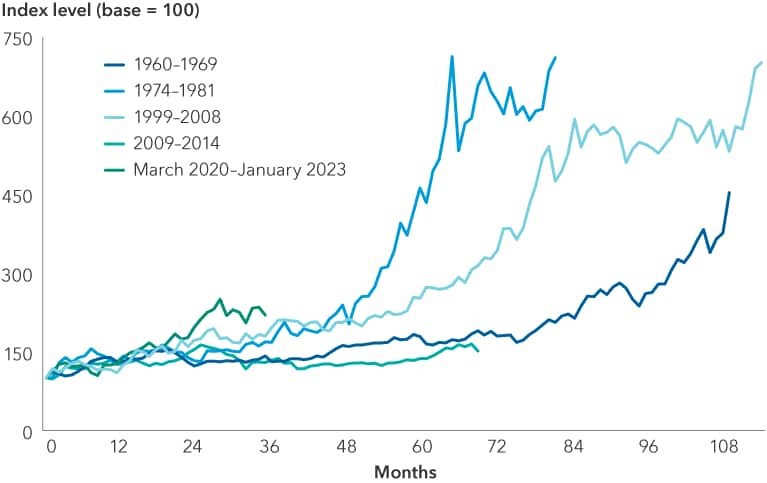Is there more fuel in the tank for energy stocks?
That’s the question on many investors’ minds as the energy sector solidly outpaced all others over the past two years. Historically, the trajectory of oil prices has been a good gauge of prospects for the sector, as the price directly impacts many companies’ bottom lines. But thus far, 2023 appears to be deviating from this tried-and-true correlation. Oil prices took a tumultuous ride over the past year, recently returning to near where they started in 2022, but energy stocks have mostly held their gains.
- Will the Bull Run for oil equities continue?
We believe we’re in the early stages of a multiyear bull run for oil stocks. That does not mean the energy sector — which has been led by these companies — will move in a straight line. Amid long uptrends, there are also mini-cycles, some lasting months to a year or more, in which short-term factors outweigh longer term supply-demand trends. Overall, we see investment opportunities over the next three to five years.
China’s reopening and lifting of COVID-19 restrictions is likely to push oil demand to new highs, with the International Energy Agency forecasting that consumption will increase by nearly 2 million barrels per day. Meanwhile, there is a structural supply shortage due to many years of underinvestment by oil companies in new capacity; production cuts from the Organization of Petroleum Exporting Countries (OPEC+), with output undershooting supply targets; and declining U.S. shale inventories. It will take many years before supply catches up with demand. These factors could help keep oil prices above $70 per barrel.
Analysis of prior energy equity bull markets (we show Canada, as an example, in the chart below) suggests we may be at the beginning of a period of valuation growth for the sector. Supported by higher energy prices, companies in the sector generated a record-breaking estimated $1.4 trillion of free cash flow in 2022, while valuations seem poised to grow across a number of metrics, including price-to-earnings and price-to-book ratios. And the resilience of oil stocks in the face of falling oil prices over the last three months suggests investors are looking past any near-term weakness in the underlying commodity price.
Energy equity bull markets have often shown staying power

- What are top spending priorities for oil companies?
The industry business model has largely pivoted from a focus on high growth and reinvestment in production to a focus on higher dividend payouts and more capital discipline. This has been one of the most pronounced changes we’ve seen in our lifetime. And this trend looks set to continue. Record-breaking cash flow over the last 12 months has left oil producers with some of the strongest balance sheets in history. Nearly 40% of executives from the top 100 oil and gas companies in the U.S. indicated debt reduction and shareholder returns as their top capital allocation priorities, according to a 2022 study by Deloitte.
The shortening and steepening of the cost curve is benefiting oil producers

This renewed focus on shareholder returns has emerged because investors are demanding capital discipline. Investors who are willing to engage now are pressing for dividends and share buybacks rather than reinvestment at higher prices. It is likely going to be another 12 to 18 months before we see producers start to reinvest in their businesses while still maintaining a sharp focus on capital discipline and return on investment.
Supply-demand dynamics also support higher oil prices. Widening OPEC+ production deficits and forecasts of dwindling global spare capacity suggest that supply will not catch up to demand for years. Of the major oil-producing countries, Saudi Arabia could increase capacity by a million barrels per day and the United Arab Emirates by another million. But it would take years to build out that capacity, and U.S. production is slowing quite quickly. Taken together, there’s just not enough oil to bolster global supply.
Moreover, exploration costs are going up. Higher quality oil reserves have been used up, and as exploration goes further afield, it gets more expensive and requires greater expertise. U.S. exploration and production companies lack the proficiency for advanced exploration and will likely have to acquire companies that know how to tap into such oil fields to bring new supply to market. Additionally, oil services costs have risen with inflation. While higher costs will impact the entire industry, they’ll most acutely affect smaller companies that have fewer resourcing options.
Taking demand and supply dynamics into consideration, in our view, oil will likely not dip below $70 per barrel under most scenarios, and our analysis shows this would allow the major oil companies to maintain profitability, even when factoring in inflation and higher costs of production.
- What is the impact of the Inflation Reduction Act on energy companies?
The Inflation Reduction Act of 2022 is a landmark piece of legislation. The bill directs $369 billion in federal funding to clean energy tax incentives, loans, and consumer and commercial subsidies that have the potential to improve the return profile in areas such as carbon sequestration and clean hydrogen infrastructure build-out.
Over the next decade, the legislation could help unleash a wave of capital expenditure. Oil and gas companies, chemical producers and auto manufacturers are among the potential beneficiaries. Only a handful of the U.S. supermajors have scalable low-carbon projects underway, but the subsidies in the Inflation Reduction Act are likely to move others off the sidelines.
Amid the optimism, it’s fair to say that some firms are proceeding cautiously, mindful that policy priorities are often subject to political shifts. While the Biden administration has supported investment in renewables, there’s no guarantee that policy wouldn’t shift back in favor of fossil fuels after the next election or if energy prices become too high.
- How do European and U.S. companies differ in their approaches to decarbonization?
Oil and gas companies, regardless of region, are seeking new ways to reduce emissions in their operations. One of the key drivers of this change in behavior has been the proliferation of net-zero targets, in which new human-produced greenhouse gas emissions are balanced by an equal reduction.
European oil and gas companies are proactively seeking replacements for their fossil fuel businesses, while U.S. companies are primarily focused on removing carbon from their existing businesses. They are leveraging tactics such as carbon sequestration — in which carbon dioxide is removed from the atmosphere and held in solid or liquid form — rather than diversifying their energy mix.
Like their U.S. counterparts, European firms are incentivized by new legislation. The REPowerEU plan, adopted by the European Commission in March 2022, directs nearly 210 billion euros in new investments toward clean energy in the European Union. The bill finances new energy partnerships with renewable and low-carbon gas suppliers, as well as clean hydrogen projects and solar and wind build-outs.
European supermajors are investing more capital into low-carbon investments

Failure to invest now in renewable infrastructure raises the risk of companies being disrupted later on. There’s also a risk of market share loss as overall demand for renewables increases
- Where do you see areas of relative value?
There’s a fairly widespread view that production costs are high in Canada’s oil sands, located in the Alberta region. But the facts on the ground are changing. The cost of oil production there has declined over the last two decades. The long-life, low-decline nature of these assets means the capital intensity required to maintain operations is comparatively low versus U.S. sources, and it enables high free cash flow generation, which is cash flow in excess of the company’s operating and capital expenses. In addition, Canadian oil sands stocks often trade at a lower valuation than the U.S. exploration and production peer group, partly because of environmental concerns and the high carbon intensity of production per barrel.
Elsewhere, the management teams of select U.S. and European oil giants are operating with the strongest capital discipline seen in decades, and dividends may offer some cushion for investors if oil prices soften. The supermajors may benefit from higher-for-longer oil and gas prices supporting exploration and production companies in addition to record high refining margins. However, on a valuation basis, the European supermajors trade at a wider-than-usual discount versus their U.S. peers on price-to-earnings multiples, despite very similar business characteristics.
European supermajors trade at a significant discount to their American rivals





